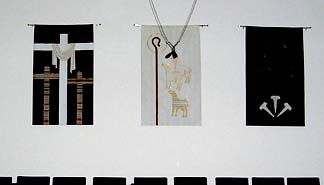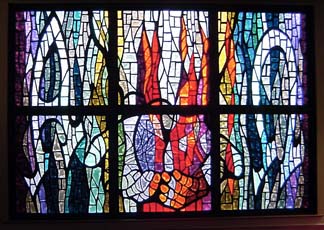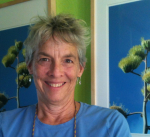The art quilt diptych (see the post of a couple of days ago) and side banners were installed at San Pedro Presbyterian Church, thanks to the assistance of custodian Luis, whose drill, ladders and manual competence were greatly appreciated. Here's an in-progress shot, and a "before", showing the off-the-rack church banners that my work is replacing.


Liturgical tapestries and wall hangings are, of course, nothing new in the world, and I have liked thinking about that continuity, my connection to the sorority of women whose skills and imagination have stitched sacred cloths for altars and choir lofts for as long as such places have existed. Maybe longer -- it's not too hard to imagine open air altars with cloths and banners, celebratory clothing and covers for sacred objects, existing before walls were built to enclose such ceremony.
The research has appealed to my inner historian, and that one who might once have lived in a cloistered order.

The key imagery and design reflects that of the symbols and images of this contemporary sanctuary's stained glass windows: the green leaf to stand for the growth of both Genesis and the Church (local reference with the cactus), the flaming heart and hands symbol of John Calvin (founder of the Presbyterian Church), the City of God with its golden rooftops (including the roofline of Mission San Jose), the silhouette of the crowing cock, a symbol of St. Peter (San Pedro). The cross motif has as its central emblem, the sun (Son).
The side banners, overdyed silk of various weaves, allow for changing colors and themes, to reflect the most important seasons of the liturgical year:
Advent and Christmas (combined): Gold
Lent: Violet/deep purple
Easter Sunday: Gold
Pentecost: Scarlet
Ordinary Time: Green
 Monday, September 11, 2006 at 10:36PM
Monday, September 11, 2006 at 10:36PM 
 Art Cloth
Art Cloth 











